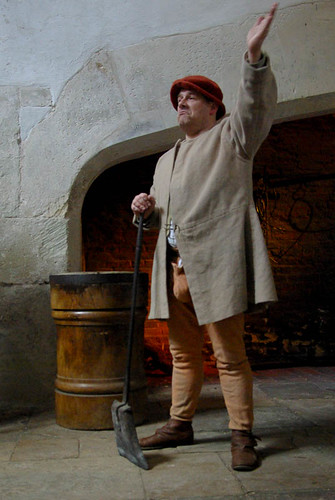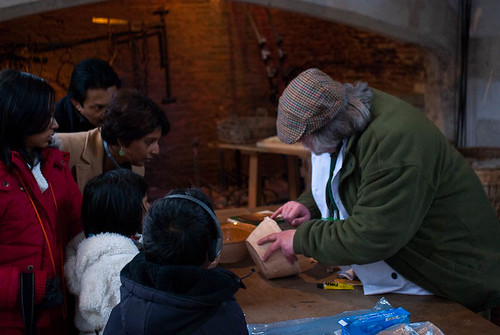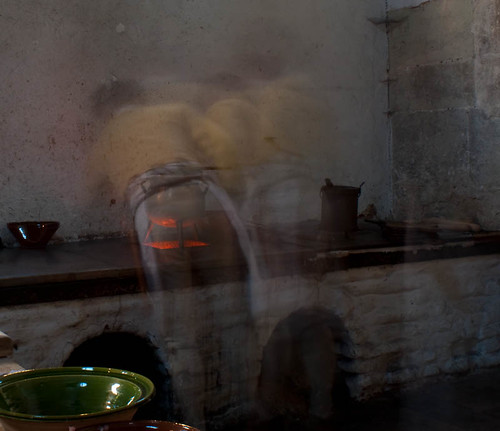First things first....7 more images from the last cookery weekend are now up at Flickr. They include Jorge doing his best (let's face it, as yet only) Mussolini impression

Barry engrossing a family with something as simple as broken pots

....and some more arty faff

I've still got a few more to put up I think (no promises) as the majority are reserved for an end of year report, but I'll see what I can turn up for the next posting.
Now on to answer Doc's questions about tables. All the furniture that the team uses is made by Robert out of air dried English oak, some other woods are used for other items but by and large oak predominates. In the case of the tables that prompted the question (see the comments on this post) the tops are separate from the trestle legs....it can be a pain sometimes when the public lean on the tops moving them about, but it does allow then the conversation about the use of furniture in the Palace and it's sometimes 'temporary' nature. Today we are used to furniture being left set in a room but for the Tudors, especially at Hampton Court that wasn't always the case.... the Great Hall for example was used for other functions than dining at different times and as such the tables that are assumed to have been in there (and that's another story not for now) would need to have been dismantled and removed....something that would seem odd in our houses today, but just think of a large catering event like a wedding with the room being dressed then cleared away.....but I digress!
We do have some tables where the top is fixed to the legs in various different ways, most of which are used as part of the static display to be both safe and historically correct....if I remember I'll take some pictures next time I'm in the kitchen for you to see.
The thickness of the tops is down to the timber available at the time of construction, but it's usually around 1/2 to 3/4 of an inch I believe (the younger readers will have to convert that to metric themselves I'm afraid)....in the past we had some thicker tops that we used but to be honest none of us are getting any younger and having to lug them out of the store then back again was quite literally a pain in the neck.....and back! The thickness differences in the tops that you noted make no real difference to the tables.....they both stay put in use and (touch proverbial wood) haven't proved to be any sort of problem yet.
The height off the floor I can't exactly remember, but an easier way to think is how far are they away from your hands. If you stand upright next to the tables your knuckles of a clenched fist for kneading are about 1 to 2 inches above the surface. This means that when you lean into the work, the surface is at a comfortable working height (and purely by coincidence the perfect height for all our codpieces to rest on the table tops if we aren't careful?!?!) unlike a modern kitchen counter which is no longer at a height suitable for 'real' cookery like pastry making and so on.....when you talk to people about it you can suddenly see that 'light bulb above the head' moment when they realise why they find cookery a chore or hard work.......I personally would recommend working on a kitchen table rather than the fitted counters, they are usually at a better height for most people, try it out next time you're in the kitchen and you'll see what I'm on about.
Hope that answers the questions Doc and is of some interest to the rest of you.

7 comments:
Very interesting,I had no idea how talented Robert was,and he knits his own stockings,a very handy man to know.Must go,my porridge is getting cold,much love no.1 fan
Fantastic answer - Thank you very very much!
I've been talking on and off about making a couple of tables like these as part of a portable kitchen setup and this adds all sorts of fuel for thought.
Is that cap of Barry's really a Tudor style?!? Also, what are Adrian and Dave up to? Any sugar work planned for Easter?
Hello,
Actually, Robert didn't knit his own stockings - his Mum Valerie did. She is an exceptional needleworker and seamstress, and has made Robert's Georgian hose and gloves, as well as the Tudor stockings, and helps him sew his clothing too.
Mary-Cat Hoare
Robert is a very talented individual who hides it under a rather large bushel.
I have to say all of the team are surprisingly talented in some quite unique ways.
It amazes me when I sit back and think past the beyond-surreal nature of our 'conversations' that there is more to the team than meets the eye, or nostril for that matter.
Very nice to see our regulars this weekend, and why oh why is that fat bloke in all the pictures? Wife has just told me that it is not just the one bloke....
That picture of Jorge with the helmet makes him look like an orc or some porcine creature, sigh.
Hello guys, your blog is just wonderful. I'm learning loads from it, and I'm not even all the way through the earlier blog postings.
I'm a cook's apprentice in a medieval recreation group in the states, and I was wondering if I could pick your collective brains from time to time? For right now I was wondering if you could tell me what kinds of roasting jacks are used in your kitchen? We're working on putting in a kitchen at the castle that's built nearby, and we're exploring what kinds of options are feasible for us.
Thanks so much!
our roasting jack is calle Ross!
We only use man power as that's what was used in the kitchens of Henry VIII.
Post a Comment